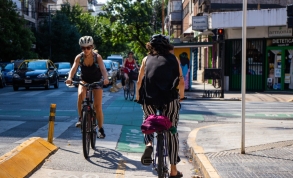Related Content

Air quality
Tokyo Vehicle Emission Reduction Program

Physical activity
New Zealand’s Model Communities Programme is a central and local government-funded initiative focusing on promotion of cycling and walking, as well as infrastructure investment, to improve urban active travel networks in two North Island provincial cities: New Plymouth and Hastings. A quasi-experimental study was conducted from 2011-2013 to evaluate whether this initiative was successful in moving away from motorised modes of transport towards active travel.
In 2018, emissions from the New Zealand transport sector were estimated to be 16,625 kilotons CO2 equivalent, representing 21% of total emissions in New Zealand. Over 50% of New Zealand's energy-related emissions come from transport, and approximately 70% of all transport emissions are from cars, Sports Utility Vehicles (SUVs), Utility Vehicles (Utes), vans and light trucks (Energy Efficiency and Conservation Authority, n.d.; Ministry of Transport, n.d.). Therefore, to reduce transport sector emissions, interventions that cause shifts from motorised vehicles to low emission alternatives are needed.
New Zealand’s Model Communities Programme aimed to promote and improve active travel infrastructure in two North Island provincial cities: New Plymouth and Hastings. As part of the programme, New Plymouth added 12 km of off-road facilities, 20 km of cycle lanes, installed cycle parking, widened path entries, created several shared spaces with reduced speed limits for vehicles (30 km/h), and ran media campaigns, events, and cycle-skills training.
Hastings added 30 km of cycle paths on arterials (roads which provide direct routes for long-distance travel throughout the city), 50 km of on- and off-road walking and cycling facilities, and undertook a ‘Share the Road’ campaign. A quasi-experimental study conducted from 2011-2013 evaluated whether the programme was successful in moving travel away from motorised modes towards cycling and walking and conducted a cost-benefit analysis of the Programme’s health and other outcomes.
Altogether, the interventions were found to result in a 30% higher level of active trips than in control cities, which equated to a 5.3% decrease in motorised trips. The Model Communities Programme resulted in a reduction of 1,150 tons of CO2 emissions between 2011 and 2013. It is further estimated that 34 disability adjusted life years (DALYs) and two deaths were avoided.
In a follow-up study conducted five years after baseline, the effect of this programme on active travel was found to be larger for Māori compared to non-Māori and for those younger than 20 years of age, over the entire post-intervention study period. The study also found that there was a larger effect for people in lower income households, for males, and for those living closer to the infrastructure provided, compared to those in higher income households, females, and those living further away from the infrastructure. However, these differences were present only during the initial period after the implementation of the intervention and were not sustained on the long term (Keall, 2022)
This intervention was successful in increasing active transport, but cycling and walking replaced shorter rather than longer car trips, and therefore had only a limited impact on reducing emissions from the transport sector. However, the cost-benefit analysis showed that the benefits, mainly from improved health and reduced injury, heavily outweighed the costs of investing in active travel, with a benefit/cost ratio of 11:1. So whilst greenhouse gas mitigation benefits may only be small, health benefits are likely to be substantial.
One key factor that supported this intervention was the availability of funds and resources from both central and local government to support implementation. Although the health benefits were considerable as shown by the cost-benefit analysis, there was only a modest impact on reduction in CO2 emissions.
The total population of New Zealand is approximately five million, of whom 87% live in urban areas. If we assume the primary target population of such interventions would be those between 15 to 65 years of age (60% of the total population) and consider the scale up of this intervention to the population of 2.6 million people that are between 15 and 65 years, living in urban areas and the same increase of 30% in active travel equating to the 5.3% decrease in motorised trips across the target population, the programme could result in a total of 20 kilotons CO2 avoided, which is still far below what would be required for meaningful effects on climate change.
The lack of public transport in the provincial cities means that the car trips that are being replaced with active trips tend to be short, with a limited impact on carbon emissions. In New Zealand, car ownership rate is about 86%, one of the highest in the world. The approach that New Zealand's political parties have relied on for the reduction of emissions from transport has been the electrification of vehicles. However, with the high rate of car ownership, this approach alone is not practical (Callister and O’Callahan, 2021). Although a city can make active journeys more attractive by interventions that aim to improve cycling infrastructure and safety, relatively few of the trips may be direct substitutes for car journeys. Therefore, for interventions to succeed in achieving higher reductions in GHG emissions, reducing motorised trips is key, as well as a system change that includes short- and long-term measures to restrict the use of vehicles and increase the use of public transport.
Currently, the Auckland Development Strategy allows for Auckland’s size to increase by 25% in 30 years, which might be an underestimation if private plans are taken into account. This could increase sprawl and result in land which could have been used as green spaces to instead be converted into housing developments. Therefore, it is important that the Development Strategy is reconsidered to limit developments that lead to this expansion, focusing instead on bringing amenities to areas that are currently lacking them, to improve access and proximity for residents.